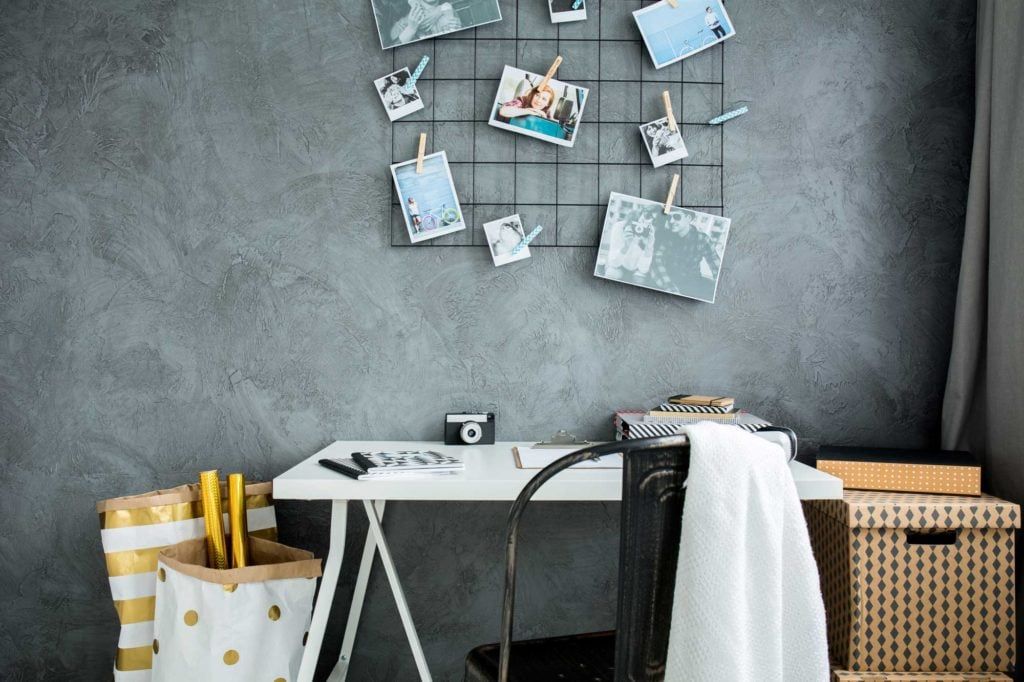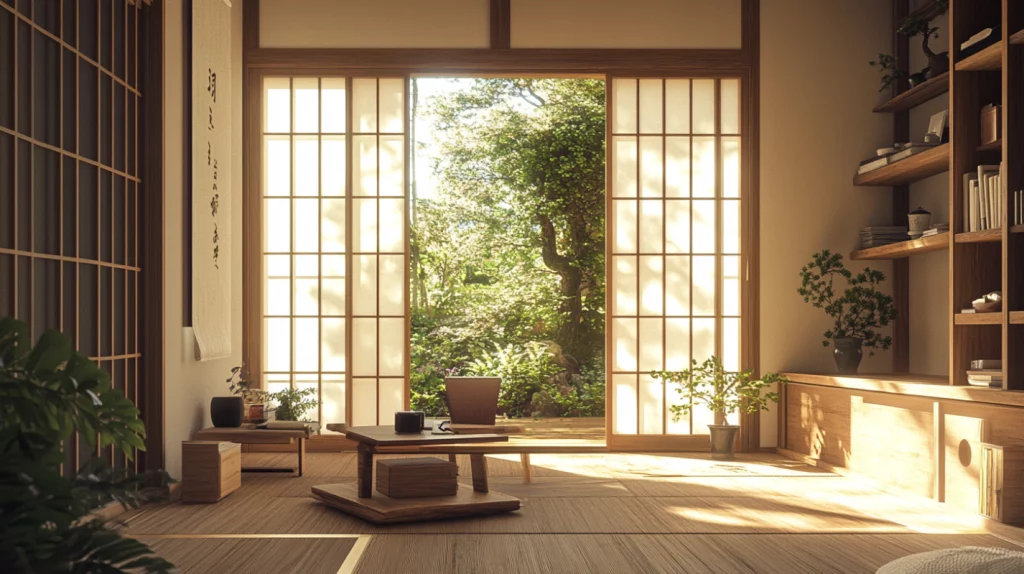
Are you looking to create a peaceful home office that combines Japanese minimalism with Scandinavian functionality? Through the power of artificial imaging, check out these 22 Japandi-inspired ideas that will help you design a serene workspace.
From furniture choices to color palettes, each idea blends simplicity and comfort, making your work-from-home experience more enjoyable and productive.
I’ve always loved the minimalist look in a home office and a Japandi-style home office lends itself to the minimalist look. Incorporating a Japandi style home office should not only add a level of class to your workspace but should also spur productivity in the space.
1. Minimalist Desk Setup
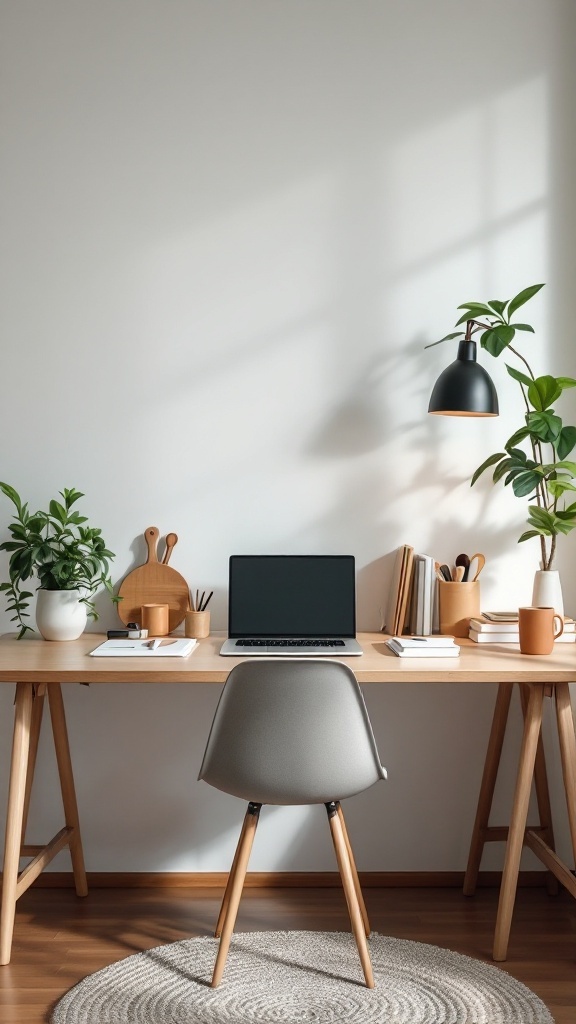
In a Japandi home office, a minimalist desk setup creates a calm and inviting atmosphere. The image showcases a sleek wooden desk paired with a comfortable chair. A laptop sits at the center, emphasizing the need for simplicity in a work environment.
Natural elements like plants add a touch of life to the space. These green accents not only enhance the decor but also contribute to a Japanese Zen interior, promoting tranquility during work hours. The neutral tones of the room align perfectly with home decor ideas Scandinavian style, emphasizing light and openness.
Using minimal home office design principles, this setup encourages focus without distractions. The organized workspace reflects the essence of a Japandi working space, blending functionality with aesthetic appeal. This design is ideal for anyone looking to create a study room aesthetic that is both stylish and serene.
2. Natural Light Enhancement
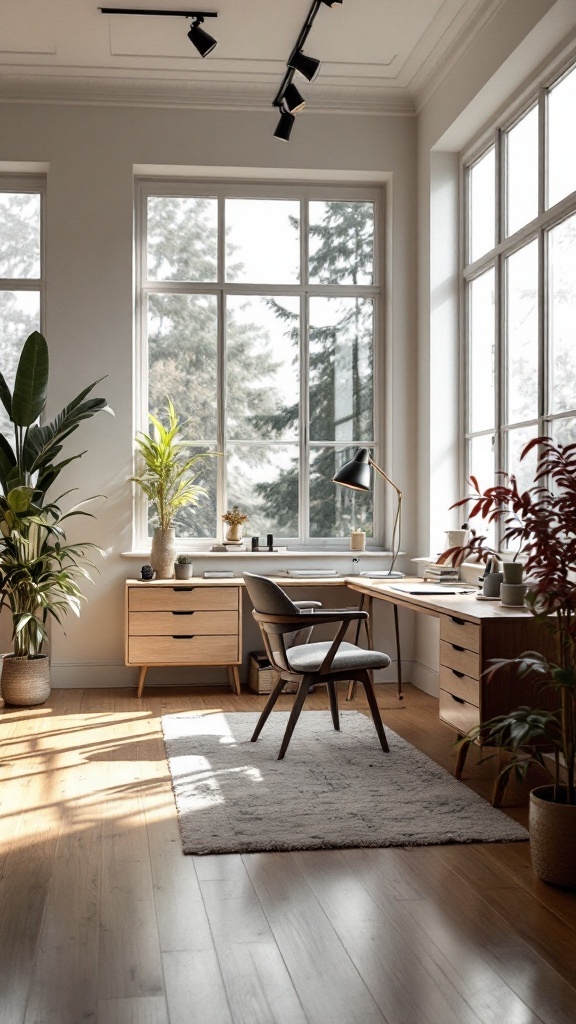
Natural light plays a big role in creating a Japandi home office. This design beautifully combines elements of Japanese and Scandinavian styles, emphasizing simplicity and tranquility.
The spacious windows in the image let in abundant daylight, making the workspace feel open and inviting. With sunlight streaming in, the room becomes a perfect Japandi workspace.
Plants add a touch of nature, enhancing the serene vibe. They also improve air quality, creating a healthier environment for productivity. This study room aesthetic encourages calmness and focus.
A minimalist approach to decor is evident. The wooden furniture and neutral tones reflect the essence of Japanese cozy home design. The simple lines and soft colors create a peaceful atmosphere, ideal for a minimal home office design.
Incorporating natural light not only boosts mood but also enhances creativity. A well-lit workspace can lead to more inspired ideas. This Japandi style home office shows how effective natural light can be in a home work area.
3. Incorporating Bamboo Elements
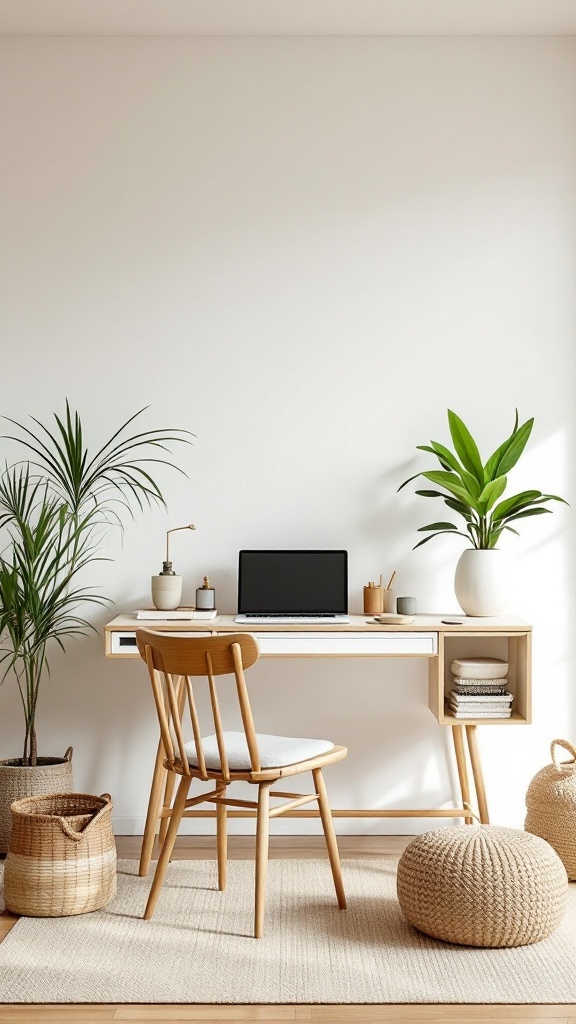
Bamboo is a fantastic addition to any Japandi home office. It brings a touch of nature indoors, enhancing the calm vibe of a Japanese Zen interior. The natural color and texture of bamboo complement the minimalist home office design, creating a serene working space.
In the image, you can see how bamboo elements can easily fit into a Japandi workspace. The simple chair and the light wood desk provide a clean look, while the greenery adds life. Incorporating bamboo baskets or decor pieces can enhance the Japanese-inspired decor without overwhelming the space.
Bamboo not only looks good but is also eco-friendly. Using sustainable materials in your home office aligns perfectly with the principles of Japandi style. This blend of Japanese and Scandinavian aesthetics emphasizes functionality and simplicity.
For those looking to create a cozy study room aesthetic, consider adding bamboo accessories, such as a desk organizer or plant stand. This will tie the room together and promote a peaceful environment, ideal for focus and productivity.
4. Tatami Mat Flooring
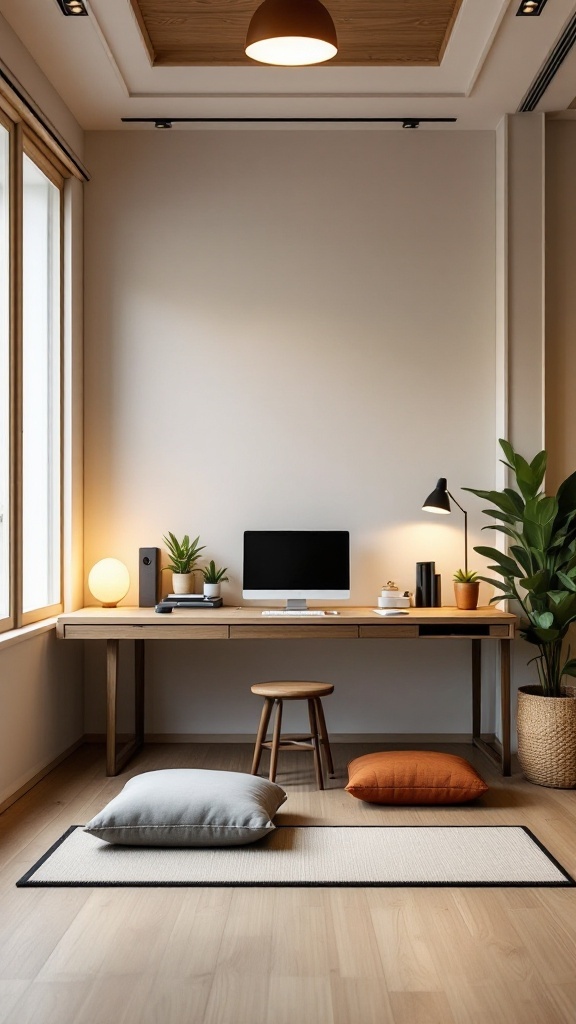
Tatami mat flooring is a charming choice for a Japandi home office. These mats, made from rice straw and covered with woven rush grass, bring that cozy Japanese vibe right into your workspace. The natural materials not only look beautiful but also add a sense of warmth and tranquility.
In the image, you can see how the tatami mats complement the overall design. The soft colors blend well with the wooden furniture and neutral walls, creating a peaceful atmosphere. This design fits perfectly with the Japanese Zen interior philosophy, focusing on simplicity and comfort.
Using tatami mats can also enhance your Japanese inspired decor. They encourage a minimalist approach, making your Japanese cozy home a serene retreat for work. Pair them with soft cushions for extra comfort while you work or meditate, turning your space into a true aesthetic work space at home.
If you’re considering a Japandi workspace, think about incorporating tatami mats. They set the tone for a minimal home office design, helping to keep distractions at bay. With this flooring, your office can become a perfect spot for creativity and focus, aligning beautifully with the principles of Japanese interior design small spaces.
5. Neutral Color Palette
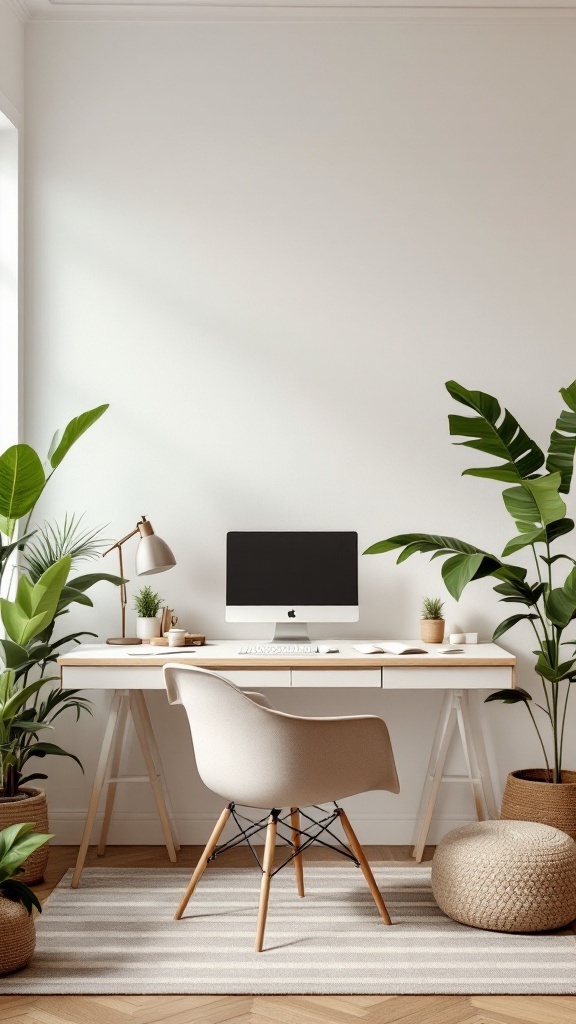
The image showcases a serene Japandi workspace, highlighting a neutral color palette that enhances relaxation and focus. The soft tones of the white walls and light wood combine beautifully with the greenery, creating a calming atmosphere.
This Japandi home office features a sleek desk, a cozy chair, and minimalist décor. The plants add a touch of nature, aligning with Japanese Zen principles while complementing the simplicity typical of Scandinavian style. Such elements make for an aesthetic workspace at home.
Choosing a neutral palette is key in home decor ideas Scandinavian style. It provides a clean backdrop that allows your creativity to flourish without distractions. This design choice is perfect for a Japanese home office, creating a space where you can effortlessly concentrate on your tasks.
Incorporating plants not only beautifies the Japandi workspace but also promotes better air quality. This thoughtful blend of design can transform your home work area ideas into a true sanctuary, ideal for productivity and peace.
6. Zen Garden Inspiration
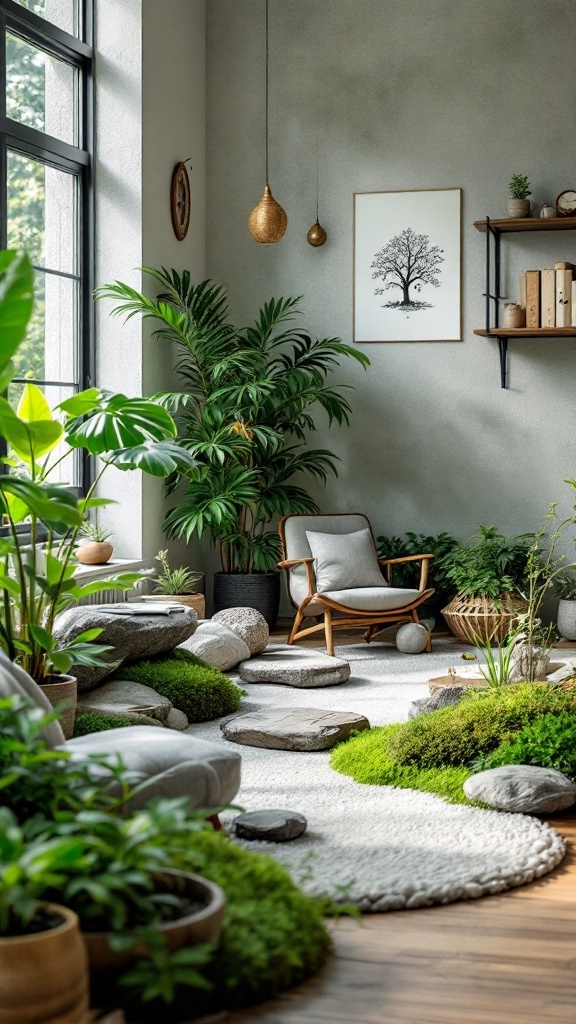
Picture a workspace that wraps you in tranquility. This image captures the essence of a Japanese Zen garden, seamlessly blended with a home office vibe. The use of soft colors and natural materials creates a peaceful retreat for productivity.
Notice the stones and moss that pave the way, inviting calmness and focus. This setup is perfect for anyone looking to create a minimal home office design that emphasizes serenity. The greenery adds life, making it a wonderful example of Japanese interior design for small spaces.
The cozy chair tucked in the corner is not just inviting; it’s a spot where one can sit back and think creatively. Such arrangements are ideal for a Japandi workspace, merging functionality with comfort. It exemplifies how a home work area can inspire productivity through simplicity and nature.
This space embodies the Japanese cozy home concept, where every element contributes to a serene atmosphere. As you design your own office, consider how a few plants or a touch of Japanese inspired decor can transform your environment into a calming study room aesthetic.
7. Functional Shelving Solutions
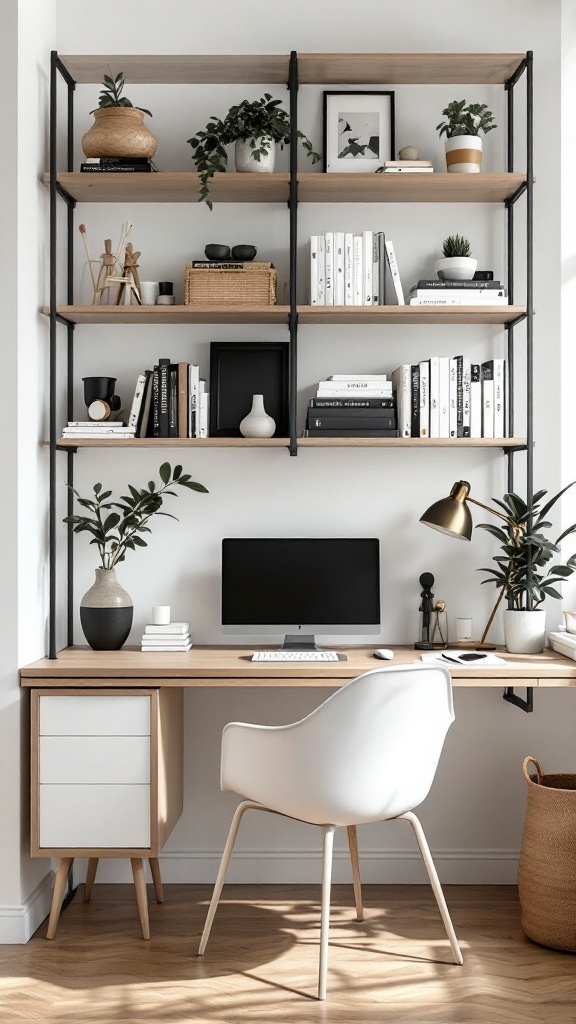
When creating a Japandi style home office, functional shelving is key. The image showcases a beautifully organized workspace that balances practicality and aesthetics. The shelves are not just for show; they hold books, plants, and decorative items that add life to the office.
This arrangement highlights Japanese interior design small spaces beautifully. The open shelves allow easy access to materials while maintaining a tidy look. By using a mix of plants and books, the decor reflects a cozy vibe, ideal for a Japanese cozy home.
The minimalist desk complements the shelving, providing ample workspace without clutter. The neutral tones in both the shelves and desk contribute to a home office neutral look, promoting a calm work environment. Incorporating these elements makes for a fantastic Japandi workspace, perfect for productivity.
For anyone considering home office neutral ideas, this design serves as inspiration. The blend of Japanese and Scandinavian styles is a hallmark of Japandi office design, creating an aesthetic work space at home that is not just stylish but functional.
8. Sustainable Materials
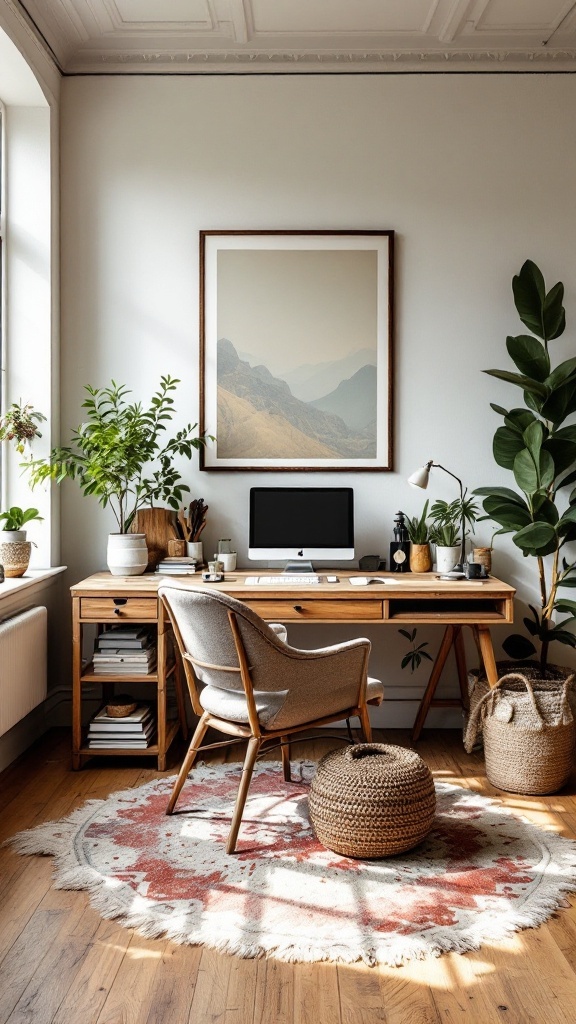
In a Japandi style home office, sustainable materials play a key role in creating a serene and inviting workspace. Think of natural woods and eco-friendly textiles that not only look great but also support a healthier environment.
The image shows a beautiful wooden desk paired with a comfortable chair. The use of natural wood brings warmth to the room, fitting perfectly with the Japanese cozy home vibe. The earthy tones and textures harmonize well with the overall aesthetic, creating a calming atmosphere.
Plants in the workspace add a touch of nature, which is essential in Japanese interior design small spaces. They not only purify the air but also enhance the overall decor. Choosing materials that are responsibly sourced aligns with the minimalist approach of the Japandi office design.
Embracing a minimal home office design allows for a clutter-free environment, making it easier to focus and be productive. The soft rug underfoot, along with the natural fibers, adds comfort while remaining true to the principles of Japanese-inspired decor.
When planning your home work area ideas, consider the harmony of materials. Aim for a Japandi workspace that merges functionality with style, ensuring that every element serves a purpose while contributing to the tranquil feel of the room.
9. Scandinavian Light Fixtures
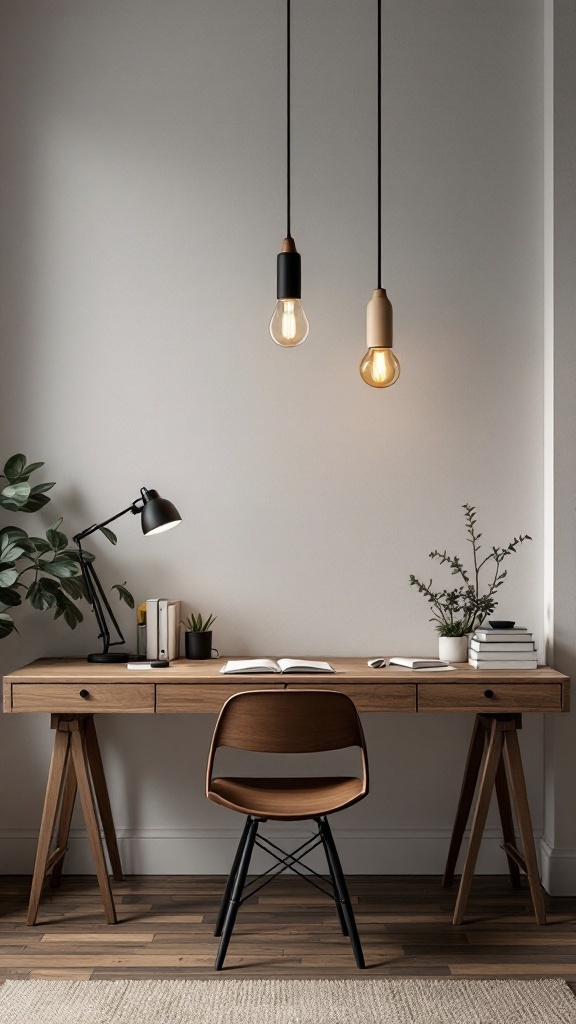
In a Japandi home office, lighting plays a key role in creating a cozy and inviting atmosphere. The image showcases stylish Scandinavian light fixtures that blend perfectly with the overall aesthetic.
The two pendant lights hanging above the desk add warmth to the workspace. Their simple yet elegant design complements the minimalist theme of a Japandi workspace. This design philosophy merges Japanese minimalism with Scandinavian functionality.
The dark and light tones of the fixtures echo the neutral palette often found in a Japanese cozy home. This neutral color scheme contributes to a calming environment, ideal for productivity. Pairing these lights with a wooden desk is a great choice in a Japandi style home office.
Incorporating such Scandinavian light fixtures not only enhances the aesthetics but also makes the office a perfect study room aesthetic. These fixtures illuminate the workspace without being overpowering, making it a great example of home decor ideas Scandinavian style.
Whether you’re setting up a home work area or looking for office Japanese style, these light fixtures are a smart choice. They effortlessly combine beauty and practicality, making them perfect for any Japandi home office design.
10. Incorporating Plants for Air Quality
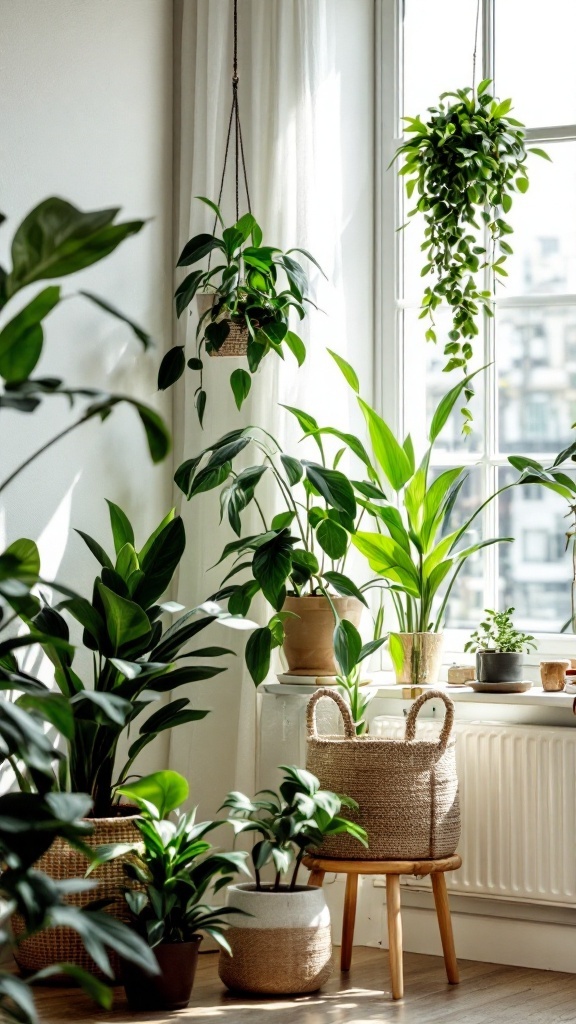
Plants can truly enhance your Japandi home office, creating a refreshing atmosphere. The image showcases a variety of greenery, showcasing how plants can bring life to a workspace.
Incorporating plants like pothos or snake plants not only elevates the aesthetic of your Japanese cozy home, but also improves air quality. These plants are known for their air-purifying qualities, making them perfect for a minimal home office design.
Consider using hanging plants to add vertical interest and save space. This approach fits well within a Japandi workspace, merging functionality with beauty. The soft light flowing through the windows highlights the lush green leaves, creating a serene environment.
Using natural textures like wicker baskets can add warmth and style to your decor. This is an easy way to bring elements of Japanese inspired decor into your office while keeping it organized.
Overall, the right selection of plants can transform your office into an aesthetic work space at home, where you can focus and feel at peace.
11. Japanese Sliding Doors
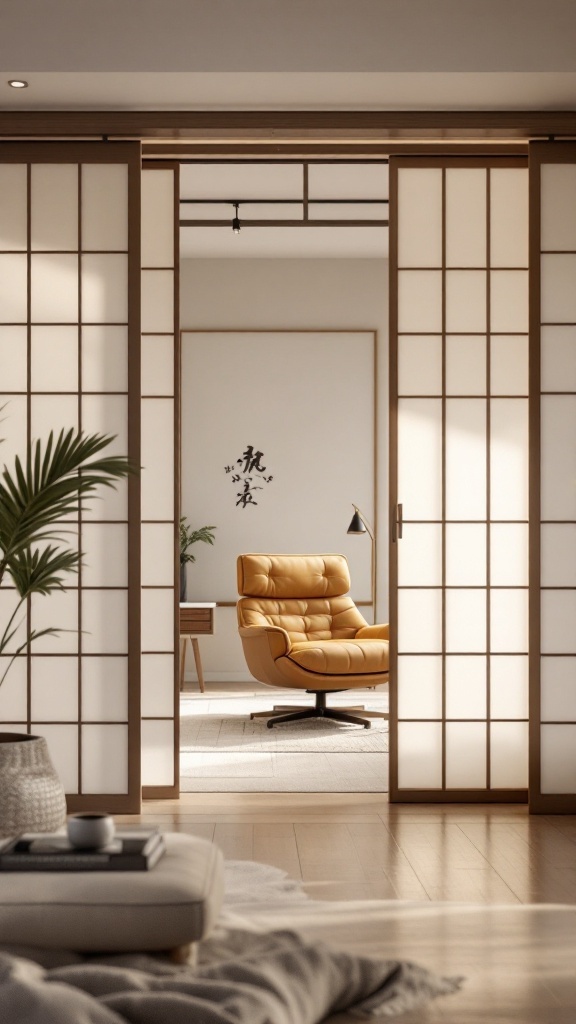
Japanese sliding doors, or shoji, are a fantastic addition to any Japandi Style Home Office. They blend functionality with beauty, providing a seamless transition between spaces. These doors are often made of wood and paper, allowing soft light to filter through while maintaining privacy.
The image showcases a serene workspace that highlights the clean lines and minimalist design typical of Japanese Inspired Decor. The sliding doors offer an inviting glimpse into a cozy office area with a stylish yellow chair, enhancing the overall aesthetic of the room.
In a Japanese Home Office, these doors can help create a peaceful environment, perfect for focus and creativity. By incorporating a shoji door, you can achieve a Japanese Zen Interior that promotes tranquility as you work. This type of design fits beautifully with Home Decor Ideas Scandinavian Style, where simplicity and nature are key.
Choosing Japanese sliding doors not only adds visual appeal but also mirrors the essence of a Japandi Workspace, balancing traditional Japanese elements with modern minimalism. They can transform any Home Work Area Ideas, making it feel more spacious and airy while adding a touch of elegance.
12. Artful Wall Decor
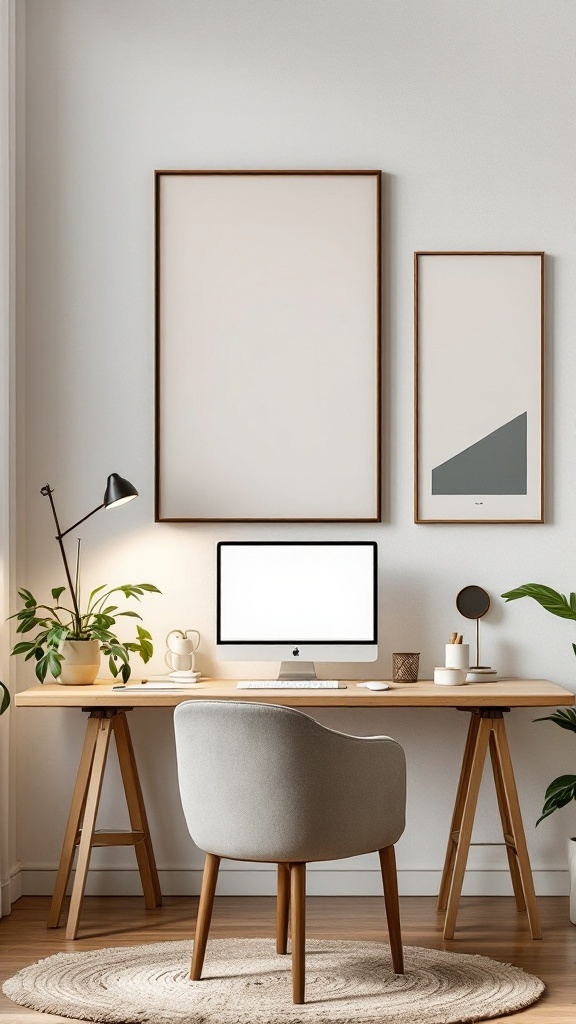
When it comes to creating a Japandi home office, wall decor plays a significant role in setting the tone. The image showcases a beautifully arranged workspace featuring minimalistic frames. These empty frames allow for future creativity, encouraging you to personalize your workspace as you see fit.
The clean lines and neutral colors embody the Japanese Zen interior philosophy, which emphasizes simplicity and tranquility. This aesthetic not only enhances the overall look but also contributes to a calm atmosphere conducive to focus and productivity.
The subtle plant adds a touch of life, complementing the minimalist home office design. Greenery is essential in Japanese cozy homes, as it brings nature indoors, aligning perfectly with the Japandi style. Whether you’re working on a project or simply enjoying your study room aesthetic, such decor inspires a serene working environment.
For those looking to mix styles, consider incorporating elements of Scandinavian decor. This blend creates a unique Japandi workspace that is both functional and stylish. Play around with different textures and materials to achieve a harmonious look.
13. Ergonomic Furniture Choices
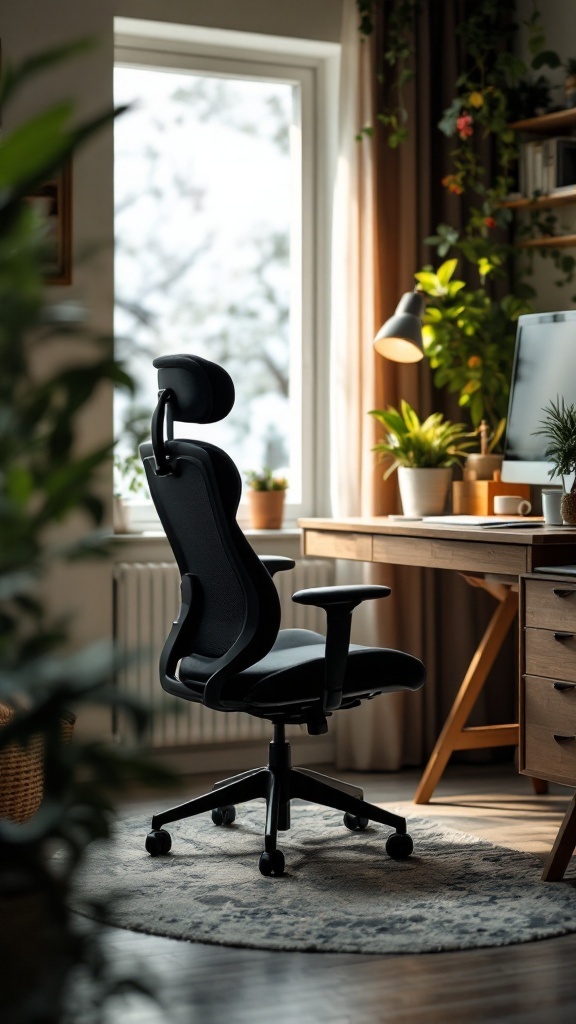
Creating a Japandi workspace is all about comfort and style, and the right furniture makes a big difference. The image showcases a sleek ergonomic chair set against a warm, inviting backdrop. This chair is not just a piece of furniture; it’s designed to support long hours of work without compromising on comfort.
The open window allows natural light to flood the space, enhancing the Japanese cozy home feel. This connection to nature is essential in Japandi design, blending functionality with tranquility. The wooden desk complements the chair nicely, reinforcing the minimal home office design aesthetic.
Incorporating ergonomic choices like this chair can transform your home work area into a healthy and productive environment. It’s a great example of how a Japandi style home office can look both chic and comfortable, promoting good posture while you work.
For anyone looking to create their own aesthetic work space at home, focusing on ergonomic furniture is key. It ensures that your Japanese inspired decor is not only beautiful but also practical. So, whether you’re setting up a new office or redesigning your current setup, think about how these elements can come together.
14. Incorporating Textured Fabrics
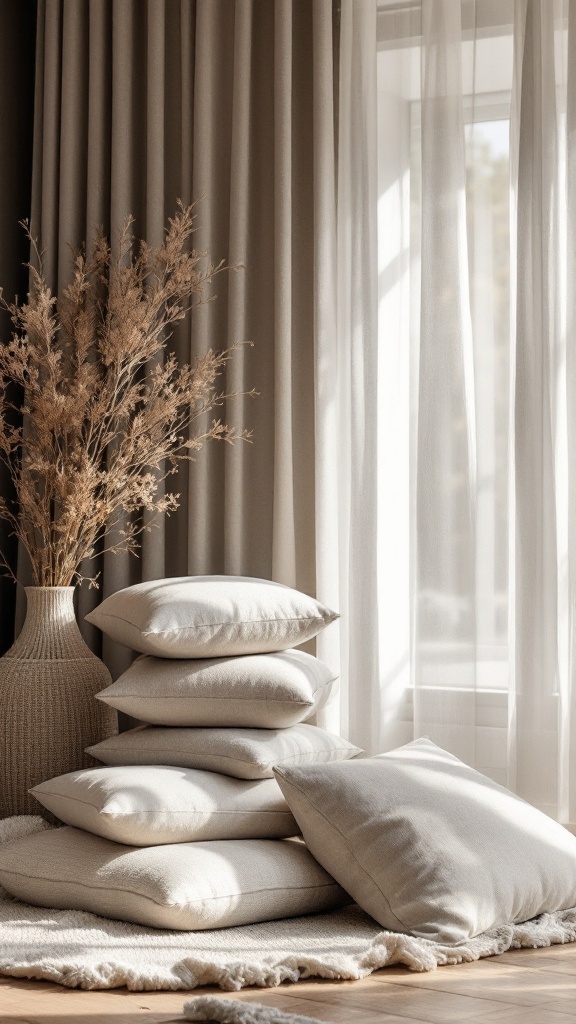
Textured fabrics can bring warmth and comfort to your Japandi home office. The image showcases a serene setting with soft cushions stacked neatly, inviting you to relax and focus. The neutral color palette blends perfectly with the peaceful ambiance typical of Japanese interior design small spaces.
Incorporating elements like these cushions and soft textiles can transform your workspace into an aesthetic work space at home. The use of natural materials, like linen or cotton, aligns well with the minimalist home office design principles of the Japandi style home office.
Consider adding a few textured throws or decorative pillows to your Japandi workspace. They not only enhance comfort but also contribute to a cozy atmosphere, making it easier to settle into your tasks. Layering different fabrics can create visual interest while maintaining the calm and uncluttered feel of a study room aesthetic.
Additionally, the presence of plants or dried arrangements, as seen in the image, adds a touch of nature that complements the Japanese cozy home vibe. Balancing these textures with clean lines and spacious layouts is key to achieving a Japandi office design that feels both functional and inviting.
15. Natural Wood Accents
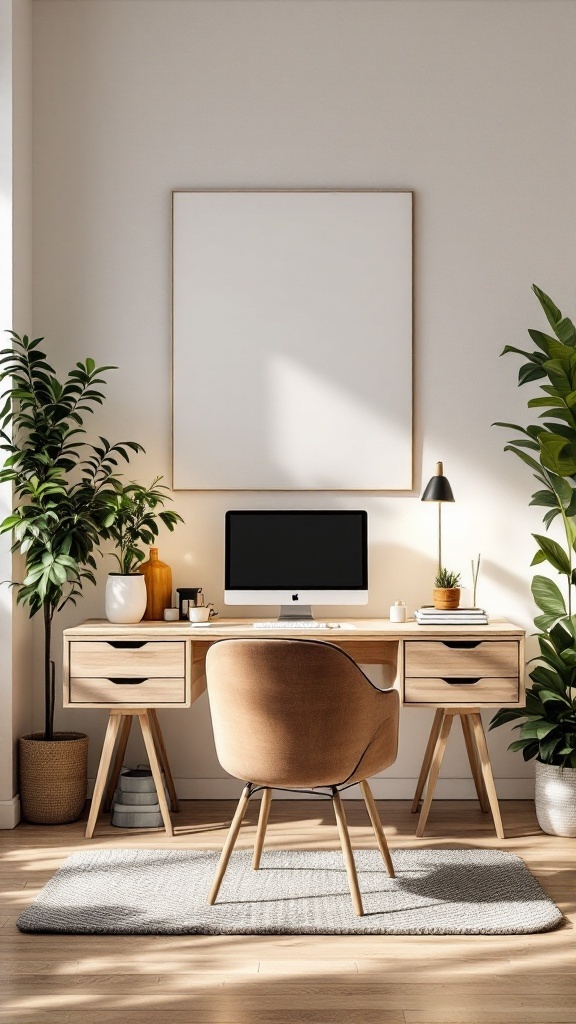
Natural wood accents play a big role in creating a Japandi workspace that feels warm and inviting. The image showcases a lovely home office with a stunning wooden desk that serves as the focal point of the room. This desk, with its clean lines and light wood finish, embodies the minimalist approach of Japandi style. It pairs beautifully with the cozy chair, making it a perfect spot to work or study.
The plants in the space add a touch of greenery, which complements the wood and enhances the overall vibe of a Japanese cozy home. Incorporating such elements can transform any study room aesthetic into a serene environment. The neutral colors, along with the natural textures, keep the area clutter-free and calming, ideal for productivity.
When designing your own Japandi office, think about different home decor ideas Scandinavian style that incorporate wood. A minimal home office design with wooden accents can help create a peaceful space. Whether it’s a wooden desk, shelves, or small decor items, natural materials are key in achieving a Japanese Zen interior. This approach not only makes the workspace functional but also aesthetically pleasing, allowing you to enjoy working from home.
16. Desk Organization Ideas
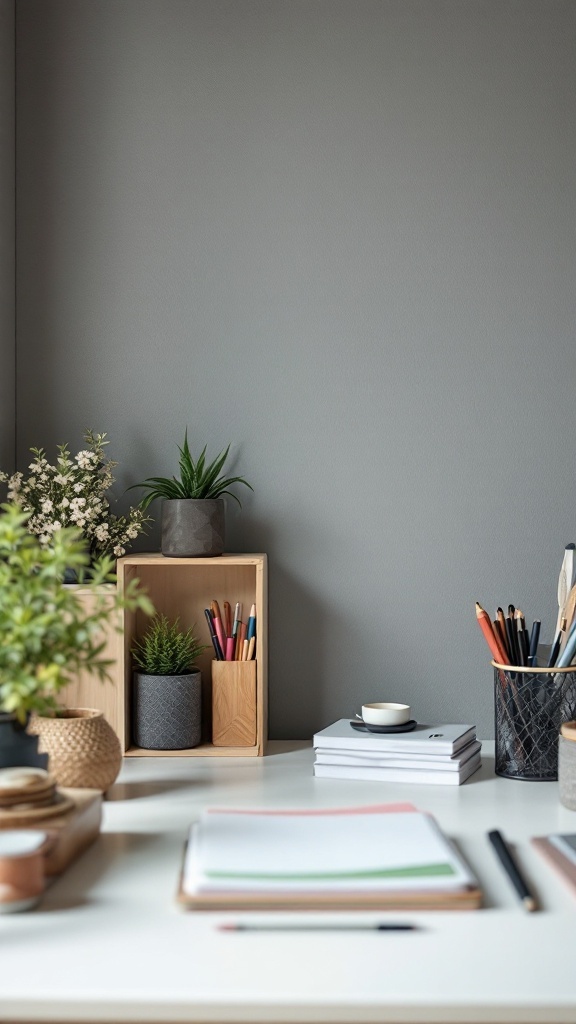
A well-organized desk can truly transform your workspace. This image showcases a serene setup perfect for anyone embracing a Japandi style home office. The minimalist approach highlights functional design while maintaining an aesthetic work space at home.
Notice the wooden storage boxes that elegantly hold pens and other supplies. These elements reflect Japanese inspired decor, blending simplicity and nature. Plants add a touch of life, enhancing the calming atmosphere typical of a Japanese cozy home.
For a Japandi workspace, using neutral colors is key. The soft grey wall provides a peaceful backdrop, while the white desk keeps things bright and inviting. Incorporating various textures, such as ceramics and wood, can enhance your home office neutral vibe.
Consider using a mix of open and closed storage to keep your home office neat. Stacking a few books and placing small decorative items can create a visually appealing arrangement. This setup not only promotes productivity but also fits seamlessly into the theme of Japanese interior design small spaces.
17. Calm Colorful Accents
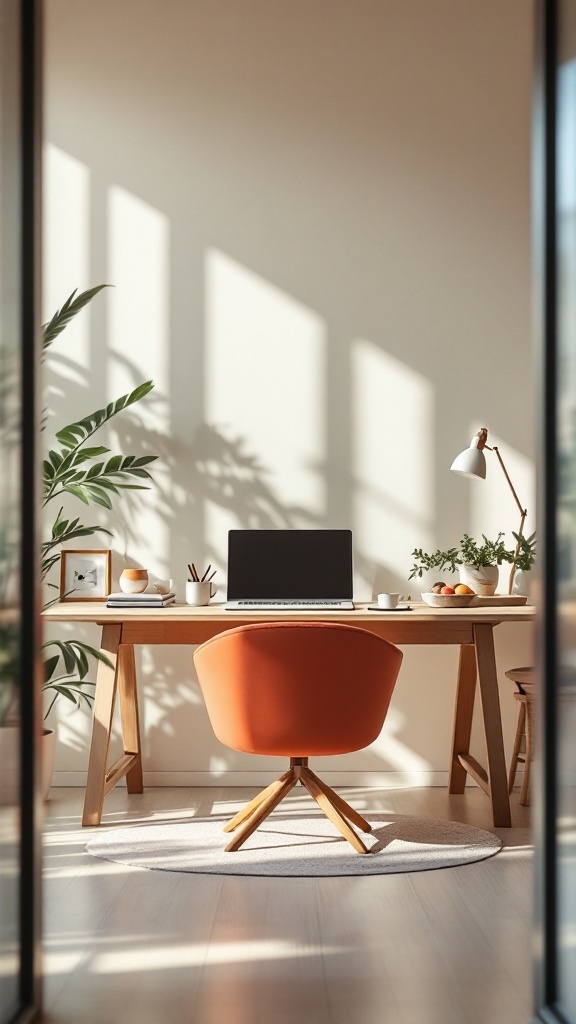
A Japandi Style Home Office beautifully blends simplicity and warmth. The image showcases a workspace that feels inviting yet minimalist. The light-colored walls and wooden furniture create a serene backdrop, while the stylish orange chair adds a pop of color, making it a unique statement piece.
Natural light floods the space, enhancing the cozy vibe typical of a Japanese Cozy Home. The thoughtful arrangement of plants and personal touches, like small decor items, reflect the Japanese Zen Interior philosophy. This design choice helps maintain a balance between functionality and aesthetics.
Incorporating colorful accents, like the vibrant chair, makes this Japandi Workspace more dynamic. The colors engage the senses without overwhelming the peace and calm that’s key in a Minimal Home Office Design. It’s a perfect example of how to create an Aesthetic Work Space At Home that inspires productivity.
18. Personalized Inspiration Board

An inspiration board is a fantastic way to personalize your Japandi home office. This image showcases a beautifully arranged board filled with photos and notes that spark creativity and motivation. Each element is carefully selected to reflect your interests and goals, creating a workspace that feels uniquely yours.
The board’s minimalist aesthetic fits perfectly with Japandi style, which blends Scandinavian functionality with Japanese Zen simplicity. Adding personal touches like travel photos or favorite quotes can transform a simple workspace into an inspiring environment. This is not just decoration; it’s about creating an atmosphere that encourages productivity while still feeling cozy.
Incorporating a personalized inspiration board into your Japandi workspace can enhance your home office’s aesthetic and functionality. It’s a wonderful way to maintain focus and positivity, making your office more than just a place to work. The combination of soft materials, neutral tones, and personal mementos aligns beautifully with Japanese-inspired decor, offering a serene and inviting study room aesthetic.
19. Tech Integration in Design
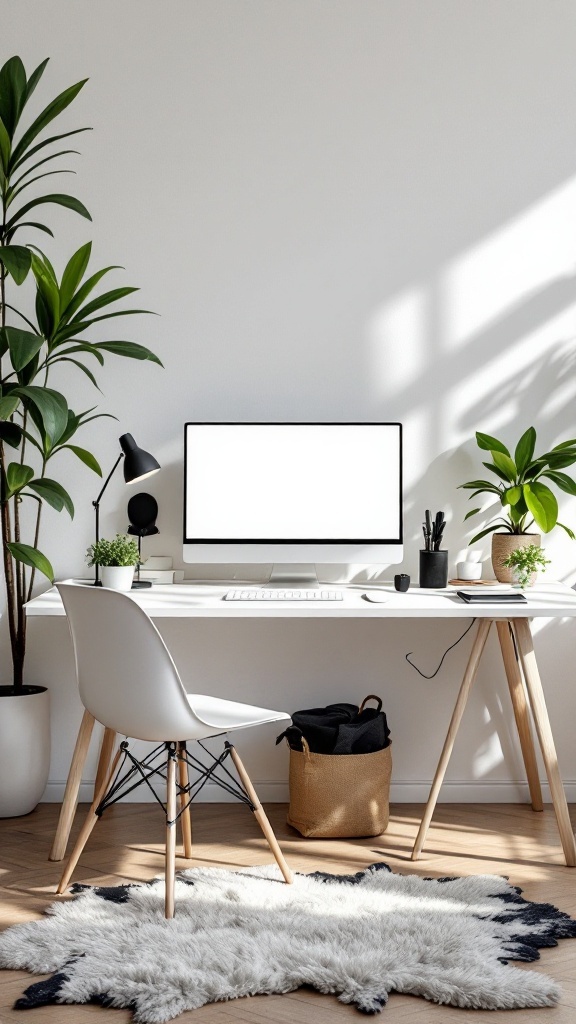
The image showcases a beautifully minimal Japandi style home office that highlights the balance between functionality and aesthetics. The clean lines of the desk and the choice of a sleek monitor create a modern workspace. The white walls and natural light add to the serene atmosphere, making it an ideal environment for productivity.
Incorporating technology into your home office design can be seamless and stylish. For example, the desk setup includes essential tech items without overwhelming the space. This creates a calm and focused atmosphere, perfect for those looking to embrace a minimalist home office design while still having access to modern conveniences.
Plants in the background not only enhance the Japanese cozy home vibe but also improve air quality, adding to the overall wellness of the workspace. This blend of greenery and tech creates an aesthetic work space at home that promotes both creativity and concentration.
Overall, a Japandi workspace can be both functional and inviting. By integrating tech thoughtfully within this design, you can enjoy a productive environment that embodies the beauty of Japanese interior design small spaces.
20. Quiet Reading Corner
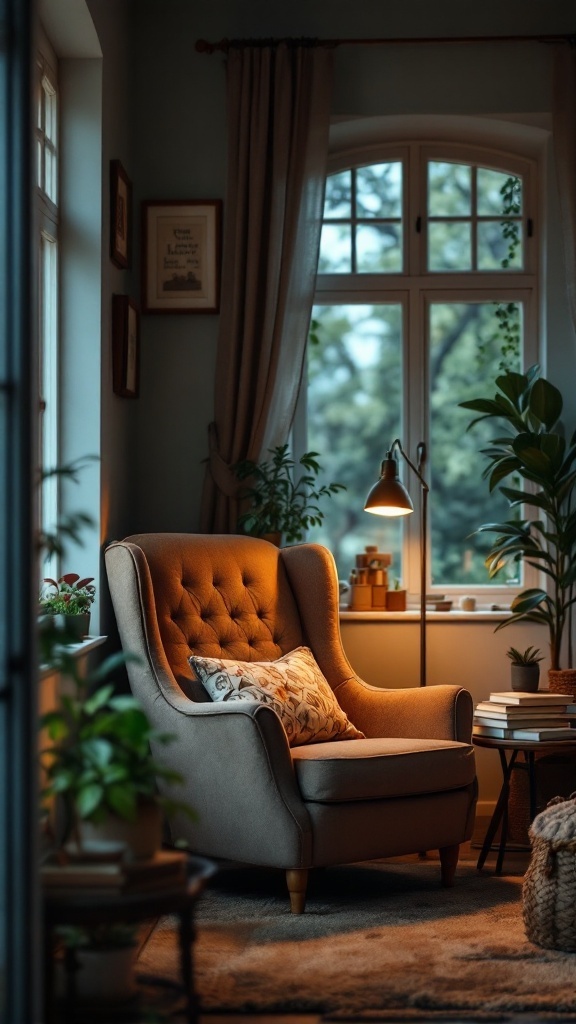
Creating a quiet reading corner in your home office can bring a soothing vibe to your workspace. This space is perfect for unwinding with a good book or taking a moment to reflect. Imagine a cozy chair, well-placed plants, and soft lighting. These elements work together to form a perfect retreat within your home.
The chair in the image has a warm, inviting presence. Its soft fabric and stylish design fit seamlessly into a Japanese cozy home aesthetic. This style promotes comfort while maintaining elegance. You can enhance this area with Japanese inspired decor, like simple art pieces or minimalistic shelves filled with your favorite reads.
Consider adding a small side table to hold your coffee or tea while you read. Incorporating soft, neutral tones can make this corner feel calm and peaceful. A Japandi workspace benefits from these design choices, blending Japanese Zen interior with Scandinavian functionality. This harmonious balance ensures your reading nook is not just a corner but an integral part of your home office.
With the right setup, your reading corner can transform into an aesthetic workspace at home. It’s a spot where you can escape the busyness of life, allowing you to recharge. This small space can bring a world of tranquility into your daily routine, making it an essential feature for your Japandi style home office.
21. Functional Workstation Layout
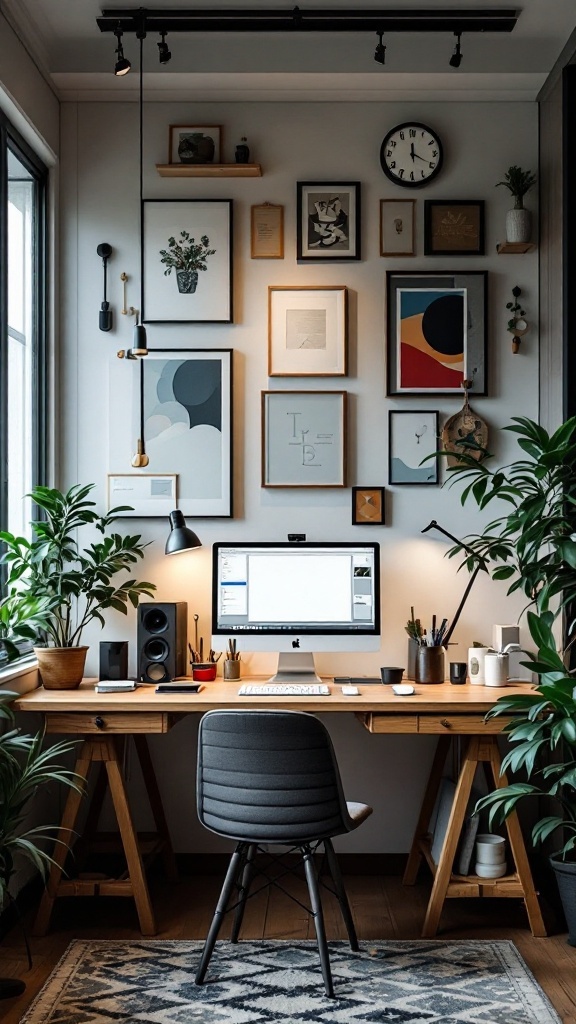
This image showcases a beautifully arranged Japandi home office that perfectly balances functionality and aesthetics. The workspace features a simple yet stylish wooden desk paired with a comfortable chair, making it an ideal setup for productivity.
The wall behind the desk is adorned with a collection of framed artworks, adding a personal touch and visual interest. This setup exemplifies a Japanese cozy home vibe through its minimalist approach while incorporating Scandinavian design elements. The plants surrounding the desk not only enhance the aesthetic work space at home but also bring a sense of nature indoors, promoting a calming atmosphere.
With the computer and essential office supplies neatly organized, this Japandi workspace maximizes efficiency without sacrificing style. The neutral color palette contributes to a serene environment, perfect for focused work sessions. This design is a fantastic example of Japanese interior design small spaces, showcasing how to create a functional yet inviting home work area.
22. Mindfulness and Meditation Space
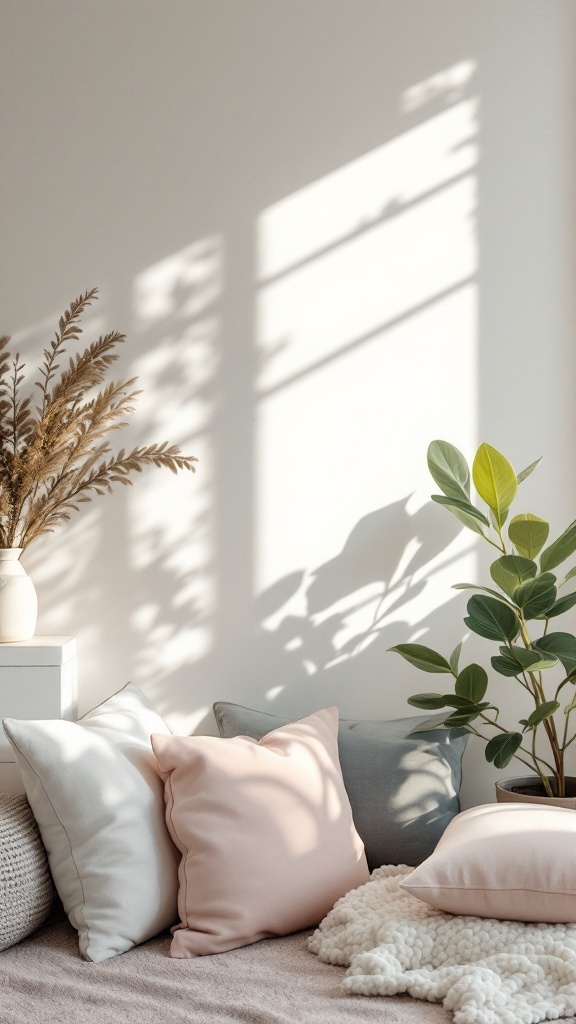
Creating a mindfulness and meditation space in your home office can boost both focus and relaxation. This serene area is an essential part of a Japandi workspace, blending Japanese minimalist design with Scandinavian coziness.
The image showcases a cozy corner with soft pillows in gentle colors, promoting a calm atmosphere. The natural light casts beautiful shadows, enhancing the peaceful vibe of the space. Incorporating plants, like the lush green leaves shown, brings a touch of nature indoors, perfect for a Japanese cozy home.
Aesthetic work spaces at home should invite calm and clarity. The neutral tones and natural materials create a feeling of tranquility. You can easily achieve this with home decor ideas Scandinavian style, focusing on simplicity and comfort.
Consider adding a few cushions and a knitted throw for warmth. This particular setup encourages you to sit back, relax, and meditate. In a Japandi home office, every element serves a purpose, making your study room aesthetic both functional and inviting.
A Japandi-style home office can be both nurturing and calming. You just might find that your productivity soars and your blood pressure wanes in this calm and serene setting.
Bob has been blogging for over 20 years and has been an office and cubicle dweller for more than 35 years. He has been featured in numerous online publications such as US News and World Report, Bustle, and Work Awesome (you can read his articles here). He created the popular office website CubicleBliss in January 2011 and rebranded it as WorkspaceBliss in April 2020.
In the office he’s been an IT Manager, Applications Engineer, Systems Analyst, Software Project leader, and Programmer Analyst in his long career. He’s a Certified Microsoft Professional and possesses a Masters of Science degree and two Bachelor of Science degrees, one of those in Informational Technology.
During his career he has worked in the office full-time, as a hybrid remote worker, and has worked from home permanently.
